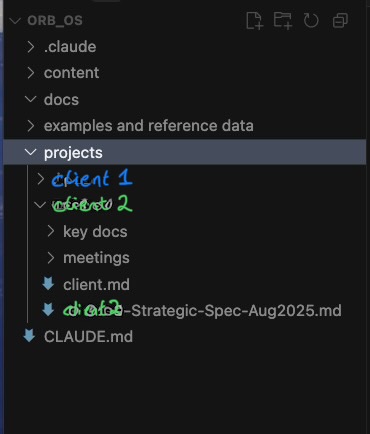Prologue
I don’t know why I did it. But I was on the way home from a meeting on the train, preparing to write up some notes and next steps on a project. When I decided to make Claude Code agents do it instead.
By showing it examples, and creating really focused Claude Code sub agents, within about 30 minutes, I had something that was generating planning documents and emails better than I’d have trusted a new junior hire.
So here we go – let’s see what this thing can do.
My starting assumption is that it’s another of those LLM experiences where it’s UNBELIEVABLE how quickly you get something working, and the temptation is to then extrapolate: “if 30 minutes gets me here, then 30 days is going to take us to the moon.” Usually the plateau is much nearer.
In this case, I think that’s actually fine. I don’t think it’s appropriate for clients to pay the usual consultancy prices and just get LLM output.
The way I think of it is: just like I wouldn’t sit and write out 1000 lines of code to make a product, why would I sit and write 1000 lines of planning?
My responsibility is to give it the signal, the benefit of my thought at the start, and the benefits of my guidance and final application of quality and standards at the end.
What have I actually done?
- Created a repo with folder structure (below) that mirrors the key artefacts and processes of working with clients. I expect this to expand over time.
- Claude.md file says we don’t be doing anything with code and tells Claude it’s my business partner. Tells it what to understand about service businesses and making them profitable, while also delivering for clients.
- Creating sub agents as I go, to be hyper focused on ONE SIMPLE TASK. One writes emails. One is a Client Partner. One is a product person, advising on how we validate ideas.
- Haven’t played with MCP connectors too much yet, but obvious potential here
- Haven’t played with generating nicer outputs, or dashboards or interfaces yet.
Oh, and just for fun, here’s a first draft about the process so far by my “writer” bot, who I asked to interview me about the project and write up its notes in the style of this blog.
It might be as good a demo as anything of the limitations. But if I can continue to craft and influence my subagents to be really really really focused – not GENERAL but SPECIFIC, I feel like there’s only value to be created here.
See what you think, and ask me any questions if you’re curious.
Day One: An AI-Native Business Experiment
Summary by content-journalist agent
Max started building orb_OS yesterday - an experiment in creating a business operating system designed for AI from the ground up.
The motivation came from a familiar frustration. As Max put it: “I spend too much time shuttling between tools, briefing AIs on context, and reformatting information. Meeting notes live in Granola, strategy docs in Google Drive, research scattered across more. Every time I want to discuss something with Claude, I’m copying and pasting fragments, losing context.”
This experiment stores everything in markdown files or similar open formats, within a structured repository. Client profiles, project scopes, meeting notes - all in formats that AI can work with directly.
Max can now say to Claude: “go and answer this question for the client” and it has access to recent meetings, background material, previous work, and his thinking on the project. As he described it: “It’s like having a really good researcher and strategist who is fully up to speed on everything.”
He contrasts this with his 2013 attempt to centralize around Asana: “At that point tools were all in their little siloes or maybe has APIs… The idea this time is because if we are truly in the AI native age, why wouldn’t we be putting our data in the best possible format for it.”
There are trade-offs. The interface lacks the polish of established SaaS tools - terminal outputs, markdown files, less visual refinement. When asked about client reactions, Max acknowledged: “Yet to be seen but I think they will love the greater efficiency. And team members will just have to get used to a slightly rougher interface. Is that so bad?”
The speed of implementation was unexpected. Max noted: “Without paying for any other products, just showing it a few examples and asking it to make a template, it can generate something that’s really close to the mark.” He estimates that service businesses could create something similar “within a day or an afternoon even.”
Whether this approach proves viable remains to be seen. But the first day suggests there might be something here worth exploring further.








